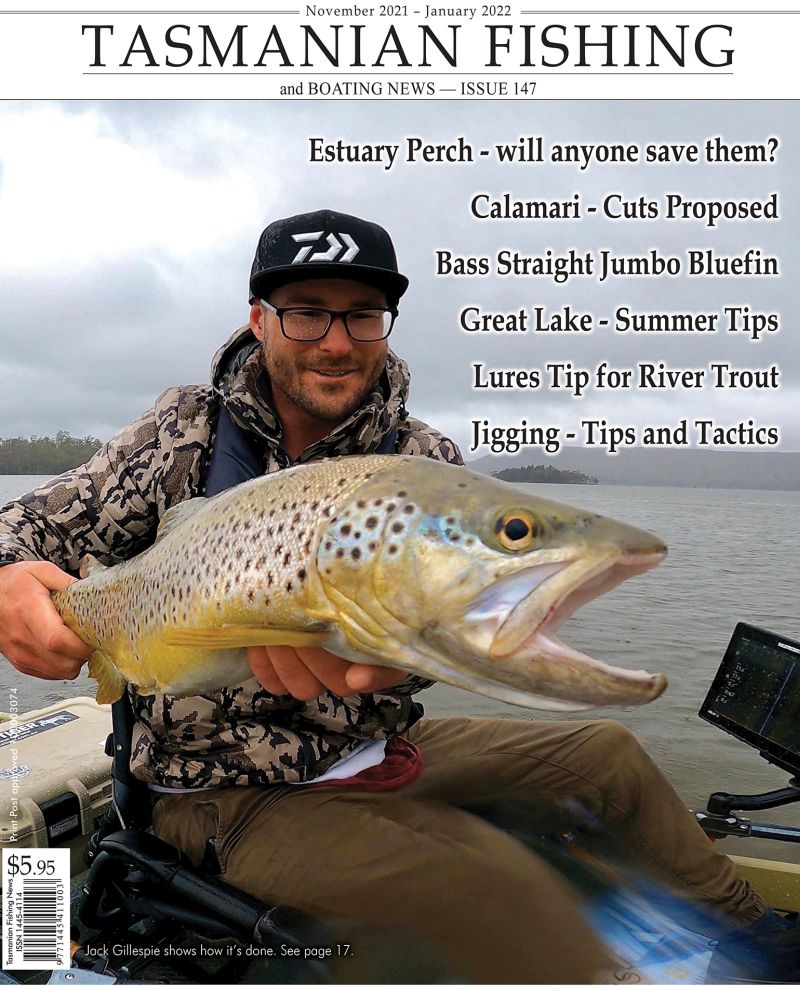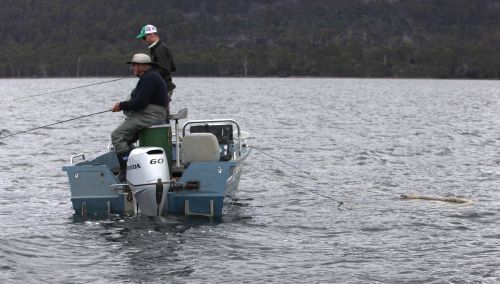From the Archives ...
Trout tips - from tackle shops
Presented from Issue 105, August 2013
We did a bit of a runaround Tasmania’s tackle stores to see what their tips for the first month or so of the tackle season were. We asked what the top three places to fish were, plus lures, flies, baits and a few other things.
Here is a rundown on their answers Whenever, and wherever you fish - anywhere, or for any fish in the world - ask the locals and especially ask at the local tackle store. They know what was caught today, yesterday and on what.
Squid: the biology basics
Squid belong to a group of animals called cephalopods, which includes the octopus, cuttlefish, and nautilus. In Tasmanian waters, we have both the smallest squid in the world, the pygmy squid at a tiny 2cm, and the largest squid - the giant squid, with squid rings as big as truck tyres. From a biological perspective, squid are rather bizarre creatures. They have not one, but three hearts - one at the base of each of two gills to pump deoxygenated blood through the gills, and one main heart to pump oxygenated blood through the rest of the body.
- Category: Saltwater and Estuary Fishing
- Hits: 5962
The Jewel of the South D'Entrecasteaux Channel
Between the mainland and Bruny Island in the states southeast lies a large stretch of water referred to as the D'Entrecasteaux Channel. "The channel', as it is affectionately known to the locals, is a mecca for both the shore and boat angler. Its numerous bays, points and islands are home for many species, which can be targeted from the shire or out in boats. Flathead, squid, mackerel and pike are amongst the most popular species, but garfish, Australian Salmon, wrasse, Atlantic salmon, cod, barracuda and various shark and ray species are also frequently encountered. It is a designated "Recreational Only" fishing area with no commercial fishing.
- Category: Saltwater and Estuary Fishing
- Hits: 21759
Stripey Trumpeter Tips
Rocky Carosi gives his tips on catching stripy trumpeter.
Renowned by many as Tasmania's finest eating fish, Tasmanian trumpeter is a fish eagerly sought by anglers all around Tasmania. In the main these are mainly fished for off the east coast and with a little knowledge and perseverance it is possible to target these and end the day with some superb table fish. Whilst they can be caught occasionally, from the shore around the Tasman Peninsula a boat in generally required. They are also available on the west coast, but most know the fishing is very weather dependant here.
- Category: Saltwater and Estuary Fishing
- Hits: 22772
Garfish - mini marlin of the estuaries
Tasmania has an abundance of southern sea garfish. They are a prime winter fish that probably grow bigger in Tasmania than anywhere else. Garfish are relatively easy to catch, and as well as being good to eat they make great bait as well.
- Category: Saltwater and Estuary Fishing
- Hits: 13072
Surf Fishing - Something for all the Family
Surf fishing is one of the most enjoyable recreational exploits now being enjoyed by a growing number of Tasmanian anglers and lets face it, a small State surrounded by water, Tasmania has more than its fair share of surf fishing opportunities for the avid angler. Surf fishing is a family oriented sport that doesn't require the cost of a boat and can be enjoyed by the whole family; even those who don't like fishing can derive much pleasure from a relaxing day at the beach whilst the fishing enthusiasts in the family do their thing. For those that haven't yet turned their attention to the surf, lets look at what tactics can help to make this day at the beach a bit more re-warding and also at the gear you will need to maximize your success.
- Category: Saltwater and Estuary Fishing
- Hits: 5087
Tidal Talk December 2001
I think I've mentioned before that I went to New Zealand last year to look at their fishery management and to talk about communication. I remember expressing my surprise at the discovery there are no flathead in new Zealand .....but they do have snapper and blue cod.
- Category: Saltwater and Estuary Fishing
- Hits: 5217
Tidal Talk
I know you'll be pleased to hear that I'm back at my desk after six weeks leave so I have forgotten half of what I knew about fishing in Tasmania.
- Category: Saltwater and Estuary Fishing
- Hits: 5414
Nautical Terms
Footloose -
The bottom portion of a sail is called the foot. If it is not secured, it is footloose and it dances randomly in the wind.
- Category: Saltwater and Estuary Fishing
- Hits: 6373
Whitebait - Compliance and Conservation
Whitebait are small, transparent fishes of around 30 - 70mm in length which migrate into Tasmanian rivers from estuarine and coastal regions each year, typically between August and December. The migratory schools may be composed of six to eight different species of fish, usually dominated by either the Tasmanian whitebait (lovettia sealii) or by juveniles of the common jollytail (Galaxias maculatus). Spotted galaxias (Galaxias tuttaceus), climbing galaxias (Galaxias brevipinnis), Tasmanian mudfish (Galaxias cleaveri) and smelt (Retropinna tasmanica) are also often present in low numbers.
- Category: Whitebait
- Hits: 7356
Tidal Talk August 2001
August is birthday month at my place. My wife Helen and two of our three children all raise the same question at the same time - what to get them as gifts. A new fly rod for Helen? a nice reel for Sam? and a new fly line for Winston? Now that's got possibilities! Might also result in more time to go fishing - alone.Speaking of birthdays, the 17th of June marked the eighth year for the recreational fishing management section in the government's Fisheries unit.
That was when Greg Double and I started working together to help manage and improve the recreational fishery. So...in eight years, what have we achieved apart from the "odd grey hair" becoming the odd black one?
- Category: Saltwater and Estuary Fishing
- Hits: 4986
Subcategories
Current TFBN
Click above for current issue content. The current issue of TFBN is extensive and topical. In Tackle Stores, Newsagents and by subscription.
Delivered to your door for $48 for 2 years (8 issues). To subscribe, send Mike $48 via www.paypal.com.au . (Basic instructions are here) The email is at Contact Us. Your address will be included from PayPal.
Or phone Mike with your c/c handy on 0418129949
Please ensure your details are correct, for Mike to organise delivery.
TFBN Newsletter Sign up Form
Why not submit an article ?
When you have finished for the day, why not have a brag about the ones that didn't get away! Send Mike an article on your fishing (Click here for contact details), and we'll get it published here. Have fun fishing - tasfish.com
Category Descriptions
Here is a list of all of the Article Categories. The number in Brackets, eg (13) is the number of articles. Click on Derwent River and all articles relating to the Derwent will be displayed in the central area.
Articles by Category
-
Rivers (3)
-
Saltwater and Estuary Fishing (149)
-
Kayak Fishing (34)
-
Lakes (1)
-
Great Lake (62)
-
Lake Leake (52)
-
Woods Lake (16)
-
Lake Augusta (11)
-
Huntsman Lake (13)
-
Lake Pedder and Gordon (10)
-
Lake Dulverton (5)
-
Lake Crescent (6)
-
Tooms Lake (10)
-
Lake Mackintosh (2)
-
Lake Barrington (5)
-
Little Lake (8)
-
Meadowbank Lake (5)
-
Lake King William (7)
-
Lake St Clair (2)
-
Western Lakes (12)
-
Arthurs Lake (35)
-
Lake Echo (7)
-
Four Springs (54)
-
Lake Sorell (7)
-
Lake Burbury (6)
-
Other Lakes (57)
-
Brushy Lagoon (18)
-
Little Pine Lagoon (5)
-
Penstock Lagoon (16)
-
Brumbys Creek (7)
-
-
Events (48)
-
Estuary Fishing (0)
-
Coastal Catches (46)
-
Super Trawler (46)
-
IFS, DPIPWE, MAST and Peak Bodies (435)
-
Commercial Interests (98)
-
Other (24)
-
TFBN Back Issues (8)
-
Fly Fishing (67)
-
Trout Fishing (252)
-
Meteorology and Weather (8)
-
Jan’s Flies (50)
-
Tuna Fishing and other Game Fishing (86)
-
Cooking Fish (19)
-
Fishing Information (1)
-
Fishing Books (8)
-
Videos (5)
-
Tackle, Boats and other Equipment (146)
-
World Fly Fishing Championship 2019 (2)
Popular Tags
windyty.com
Visit https://www.windyty.com/
Rubicon Web and Technology Training
Hello everyone, I thought it would be a good time to introduce myself.
My name is Stephen Smith and I have been managing the website tasfish.com since May 2009.
It has been an epic journey of learning and discovery and I am indebted to Mike Stevens for his help, support and patience.
I am developing a new venture Rubicon Web and Technology Training ( www.rwtt.com.au ). The focus is two part, to develop websites for individuals and small business and to train people to effectively use technology in their everyday lives.
Please contact me via www.rwtt.com.au/contact-me/ for further information - Stephen Smith.
From the Archives ... (last chance)
"Angling is an art - Hannah Ledger
and an art worth your learning.."
Presented from Issue 112, October 2014
So said Izaak Walton in the 1600s. It seems that Burnie’s Hannah Ledger has combined angling with art rather well. Hannah is a fish fanatic, outdoor enthusiast and budding, self-taught artist. From as young as she can remember, she has always had crayon in hand, colouring book under arm and as she’s grown as a painter, jars full of paintbrushes and cupboards full of ready-to-go blank canvas’.
A country girl at heart, Hannah was schooled at Yolla District High School, a small ‘farm’ school in the states North West, then went on to Hellyer College where she was given the opportunity to really grow her art skills; And by grow, that meant skipping the classes that would probably have more an impact of getting her somewhere in life, like English and Math to spend every spare minute with the art teacher, painting or drawing.
As typical teenagers do, they make poor decisions- and after being accepted in to one of the countries top art schools, turned down the offer and decided to move to the big island, where she lived for 5 years working in what seemed ‘dead end’ retail.
Read more ...


